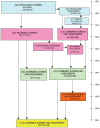Epidemiological pathology of dementia: attributable-risks at death in the Medical Research Council Cognitive Function and Ageing Study
- PMID: 19901977
- PMCID: PMC2765638
- DOI: 10.1371/journal.pmed.1000180
Epidemiological pathology of dementia: attributable-risks at death in the Medical Research Council Cognitive Function and Ageing Study
Abstract
Background: Dementia drug development aims to modulate pathological processes that cause clinical syndromes. Population data (epidemiological neuropathology) will help to model and predict the potential impact of such therapies on dementia burden in older people. Presently this can only be explored through post mortem findings. We report the attributable risks (ARs) for dementia at death for common age-related degenerative and vascular pathologies, and other factors, in the MRC Cognitive Function and Ageing Study (MRC CFAS).
Methods and findings: A multicentre, prospective, longitudinal study of older people in the UK was linked to a brain donation programme. Neuropathology of 456 consecutive brain donations assessed degenerative and vascular pathologies. Logistic regression modelling, with bootstrapping and sensitivity analyses, was used to estimate AR at death for dementia for specific pathologies and other factors. The main contributors to AR at death for dementia in MRC CFAS were age (18%), small brain (12%), neocortical neuritic plaques (8%) and neurofibrillary tangles (11%), small vessel disease (12%), multiple vascular pathologies (9%), and hippocampal atrophy (10%). Other significant factors include cerebral amyloid angiopathy (7%) and Lewy bodies (3%).
Conclusions: Such AR estimates cannot be derived from the living population; rather they estimate the relative contribution of specific pathologies to dementia at death. We found that multiple pathologies determine the overall burden of dementia. The impact of therapy targeted to a specific pathology may be profound when the dementia is relatively "pure," but may be less impressive for the majority with mixed disease, and in terms of the population. These data justify a range of strategies, and combination therapies, to combat the degenerative and vascular determinants of cognitive decline and dementia. Please see later in the article for the Editors' Summary.
Conflict of interest statement
The authors have declared that no competing interests exist.
Figures
Similar articles
-
Neuropathologic basis of age-associated brain atrophy.JAMA Neurol. 2013 May;70(5):616-22. doi: 10.1001/jamaneurol.2013.1957. JAMA Neurol. 2013. PMID: 23552688 Free PMC article.
-
Pathological correlates of late-onset dementia in a multicentre, community-based population in England and Wales. Neuropathology Group of the Medical Research Council Cognitive Function and Ageing Study (MRC CFAS).Lancet. 2001 Jan 20;357(9251):169-75. doi: 10.1016/s0140-6736(00)03589-3. Lancet. 2001. PMID: 11213093
-
Combined neuropathological pathways account for age-related risk of dementia.Ann Neurol. 2018 Jul;84(1):10-22. doi: 10.1002/ana.25246. Epub 2018 Jun 26. Ann Neurol. 2018. PMID: 29944741 Free PMC article.
-
Vascular pathologies and cognition in a population-based cohort of elderly people.J Neurol Sci. 2004 Nov 15;226(1-2):13-7. doi: 10.1016/j.jns.2004.09.004. J Neurol Sci. 2004. PMID: 15537512 Review.
-
Insights into the pathological basis of dementia from population-based neuropathology studies.Neuropathol Appl Neurobiol. 2023 Aug;49(4):e12923. doi: 10.1111/nan.12923. Neuropathol Appl Neurobiol. 2023. PMID: 37462105 Free PMC article. Review.
Cited by
-
Vascular disease and dementias: paradigm shifts to drive research in new directions.Alzheimers Dement. 2013 Jan;9(1):76-92. doi: 10.1016/j.jalz.2012.02.007. Epub 2012 Nov 22. Alzheimers Dement. 2013. PMID: 23183137 Free PMC article. Review.
-
Mixed pathology is more likely in black than white decedents with Alzheimer dementia.Neurology. 2015 Aug 11;85(6):528-34. doi: 10.1212/WNL.0000000000001834. Epub 2015 Jul 15. Neurology. 2015. PMID: 26180136 Free PMC article.
-
Towards improving diagnosis of memory loss in general practice: TIMeLi diagnostic test accuracy study protocol.BMC Fam Pract. 2016 Jul 19;17:79. doi: 10.1186/s12875-016-0475-2. BMC Fam Pract. 2016. PMID: 27430736 Free PMC article.
-
A Comparative Study of Pathological Outcomes in The University of Manchester Longitudinal Study of Cognition in Normal Healthy Old Age and Brains for Dementia Research Cohorts.J Alzheimers Dis. 2020;73(2):619-632. doi: 10.3233/JAD-190580. J Alzheimers Dis. 2020. PMID: 31796669 Free PMC article.
-
Alzheimer's Disease and Its Potential Alternative Therapeutics.J Alzheimers Dis Parkinsonism. 2019;9(5):477. doi: 10.4172/2161-0460.1000477. Epub 2019 Sep 13. J Alzheimers Dis Parkinsonism. 2019. PMID: 31588368 Free PMC article.
References
-
- McKeith IG, Galasko D, Kosaka K, Perry EK, Dickson DW, et al. Consensus guidelines for the clinical and pathological diagnosis of dementia with Lewy bodies (DLB): report of the consortium on DLB International Workshop. Neurology. 1996;47:1113–1124. - PubMed
-
- Mirra SS, Heyman A, McKeel D, Sumi SM, Crain BJ, et al. The consortium to establish a registry of Alzheimer's disease (CERAD) Part II. Standardization of the neuropathologic assessment of Alzheimer's disease. Neurology. 1991;41:479–486. - PubMed
-
- NationReagan Institute Working Group on Diagnostic Criteria for the Neuropathological Assessment of Alzheimer's Disease. Consensus recommendations for the postmortem diagnosis of Alzheimer's disease. Neurobiol Aging. 1997;18(Suppl 1):S1–S2. - PubMed
-
- Cechetto D, Hachinski V, Whitehead S. Vascular risk factors and Alzheimer's disease. Expert Rev Neurotherapeutics. 2007;8:743–750. - PubMed
-
- Green R, Schneider L, Hendrix S, Zavitz K, Swabb E. Safety and efficacy of tarenflurbil in subjects with mild Alzheimer's disease: results from an 18-month multi-center phase 3 trial. Alzheimer's and Dementia. 2008;4(Suppl1):T165.
Publication types
MeSH terms
Grants and funding
LinkOut - more resources
Full Text Sources
Other Literature Sources
Medical
Research Materials



